Lesson3 Can I try this shirt on 教案新部编本及反思
CanItrythisshirton教学设计
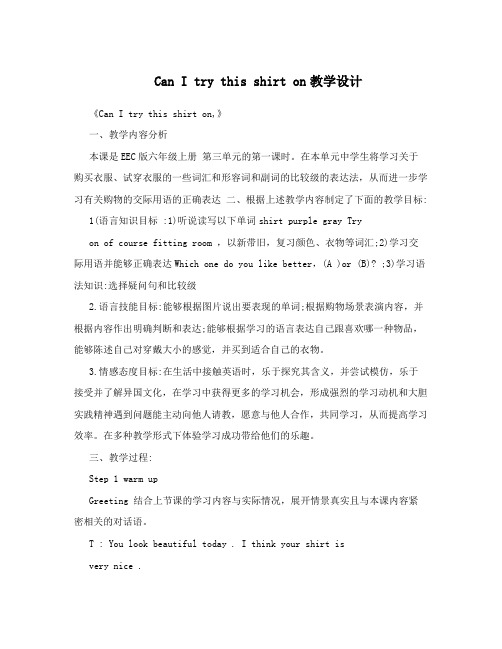
Can I try this shirt on教学设计《Can I try this shirt on,》一、教学内容分析本课是EEC版六年级上册第三单元的第一课时。
在本单元中学生将学习关于购买衣服、试穿衣服的一些词汇和形容词和副词的比较级的表达法,从而进一步学习有关购物的交际用语的正确表达二、根据上述教学内容制定了下面的教学目标: 1(语言知识目标 :1)听说读写以下单词shirt purple gray Tryon of course fitting room ,以新带旧,复习颜色、衣物等词汇;2)学习交际用语并能够正确表达Which one do you like better,(A )or (B)? ;3)学习语法知识:选择疑问句和比较级2.语言技能目标:能够根据图片说出要表现的单词;根据购物场景表演内容,并根据内容作出明确判断和表达;能够根据学习的语言表达自己跟喜欢哪一种物品,能够陈述自己对穿戴大小的感觉,并买到适合自己的衣物。
3.情感态度目标:在生活中接触英语时,乐于探究其含义,并尝试模仿,乐于接受并了解异国文化,在学习中获得更多的学习机会,形成强烈的学习动机和大胆实践精神遇到问题能主动向他人请教,愿意与他人合作,共同学习,从而提高学习效率。
在多种教学形式下体验学习成功带给他们的乐趣。
三、教学过程:Step 1 warm upGreeting 结合上节课的学习内容与实际情况,展开情景真实且与本课内容紧密相关的对话语。
T : You look beautiful today . I think your shirt isvery nice .S : Thank you . I like this shirt very much . Step 2 Presentation1.结合本节课的学习内容,通过颜色和不同衣服的名称引导学生更好的进入新知识的学习。
对话练习:让学生通过衣服的式样和颜色,描述自己最好的朋友。
部编版小学三年级上册英语教案(全册)
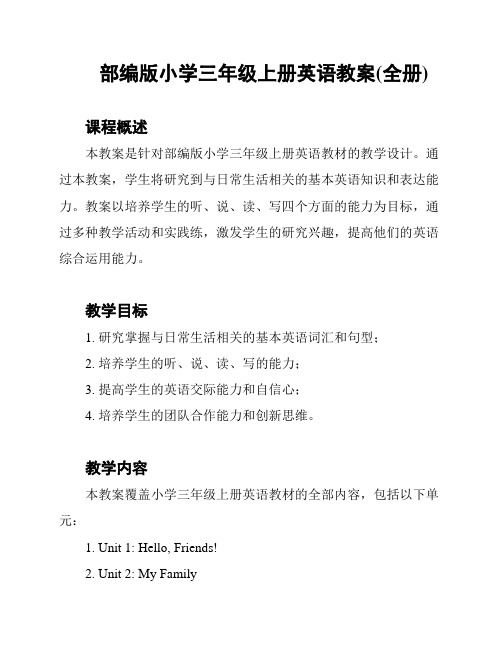
部编版小学三年级上册英语教案(全册)课程概述本教案是针对部编版小学三年级上册英语教材的教学设计。
通过本教案,学生将研究到与日常生活相关的基本英语知识和表达能力。
教案以培养学生的听、说、读、写四个方面的能力为目标,通过多种教学活动和实践练,激发学生的研究兴趣,提高他们的英语综合运用能力。
教学目标1. 研究掌握与日常生活相关的基本英语词汇和句型;2. 培养学生的听、说、读、写的能力;3. 提高学生的英语交际能力和自信心;4. 培养学生的团队合作能力和创新思维。
教学内容本教案覆盖小学三年级上册英语教材的全部内容,包括以下单元:1. Unit 1: Hello, Friends!2. Unit 2: My Family3. Unit 3: My School4. Unit 4: At the Park5. Unit 5: My Home6. Unit 6: My Day7. Unit 7: At the Zoo8. Unit 8: At the Restaurant9. Unit 9: Happy Birthday!每个单元的教学内容包括基础词汇、常用句型、听力训练、口语表达、阅读理解、写作练等。
教学方法针对每个单元的教学内容,我们将采用以下教学方法:1. 录音和口语练:通过听力材料和口语练,培养学生的听力理解和口语表达能力。
2. 视觉辅助教学:通过图片、幻灯片等视觉辅助工具,帮助学生理解和记忆新的英语词汇和句型。
3. 小组合作研究:通过小组活动,提供学生与同学合作、互动的机会,培养学生的合作能力和团队意识。
4. 游戏和故事讲解:通过游戏和故事讲解,增加课堂趣味性,激发学生研究英语的兴趣。
5. 书面练和作文训练:通过书面练和作文训练,巩固学生的英语写作能力和语法运用能力。
教学评估我们将通过定期的测验、口语表达和写作作业等方式对学生进行教学评估。
评估结果将用于指导教学进程和调整教学方法,确保学生的研究效果。
Lesson 3 Can I try this shirt on
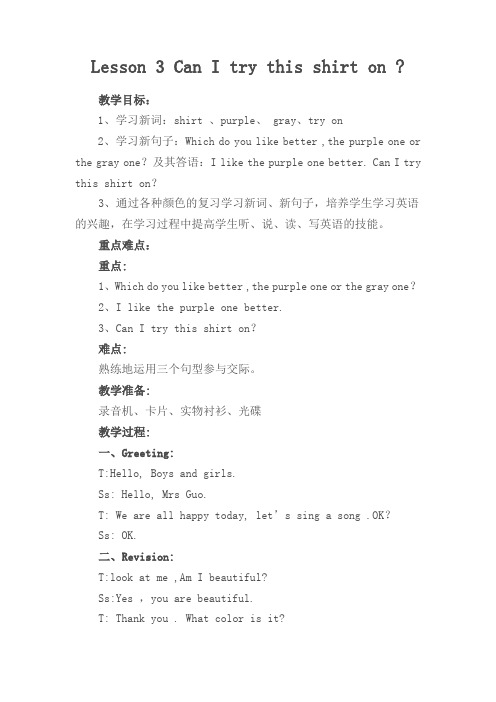
Lesson 3 Can I try this shirt on ?教学目标:1、学习新词:shirt 、purple、 gray、try on2、学习新句子:Which do you like better ,the purple one or the gray one?及其答语:I like the purple one better. Can I try this shirt on?3、通过各种颜色的复习学习新词、新句子,培养学生学习英语的兴趣,在学习过程中提高学生听、说、读、写英语的技能。
重点难点:重点:1、Which do you like better ,the purple one or the gray one?2、I like the purple one better.3、Can I try this shirt on?难点:熟练地运用三个句型参与交际。
教学准备:录音机、卡片、实物衬衫、光碟教学过程:一、Greeting:T:Hello, Boys and girls.Ss: Hello, Mrs Guo.T: We are all happy today, let’s sing a song .OK?Ss: OK.二、Revision:T:look at me ,Am I beautiful?Ss:Yes ,you are beautiful.T: Thank you . What color is it?Ss:It’s blue.T:What color is it?Ss:It’s black.(通过实物分别复习了white 、blue 、black、 yellow 、green )三、New lesson:1、 Learn some new words and spell them .T:What color is it?Ss: It’s purple.T:Say purple one by one.T: Who can spell purple?S1:p-u-r-p-l-e, purple.One by one .Study gray . shirt .2、Let’s p lay a game.Read them together.Ss: gray 、yellow 、black 、 green 、blue、 white 、purple .T: Which one is missing? Who can guess it out?He/she will get a color of card for their group.S1: Purple.T: Purple. Yes, you’re right. can you spell it?This purple star is for your group.T: Read them together.3、Study new sentences:T:I like purple shirt and I like gray shirt ,too.OK,Which do you like better,the purple one or the gray one?(板书)S1:I like the purple one better.T: Read after me,Which do you like better,the purple one or the gray one?Ss: Which do you like better,the purple one or the gray one?T:The shirt is very beautiful,I like it .Well…Can I try this shirt on?(板书)Ss: Can I try this shirt on ?T: Good! One by one to read .Next,let’s Listen to the tape .listen carefully !5、Acting:Let’s play a game. Look for five students to do exercises to the blackboard。
六年级上英语教案-Lesson 3 Can I try this shirt on_(EEC)-最新教育文档

Lesson 3 Can I try this shirt on ?(第1课时)Teaching aims:1. Learn to speak buy and sell express method.2. Speak new words of this lesson.3. Can make some sentences.Teaching contents:1. glossary: which better shop of course try on2. Sentences: Which one do you like better, A or B?Teaching important and difficult points:I like A better.big- bigger --biggestsmall- smaller--smallest too smallTeaching phrasing:1. look good take2. Do you have a bigger one?... is too ... for...Teaching aids:tape pictures and computerTeaching Steps:Step1.Warm up1. Greetings.2. Sing the chant.3. Ask and answer.4. Correct their mistakes.Step2Revision1. Ask the contents of dialog.2. Translate into Chinese.3. Speak and read.Step3New lesson teaching1. Show them pictures of shop.2. Tell them to go into the shop.3. Speak buy and sell expresses method.4. Correct their mistakes.5. Listen to the tape.6. The student borrows own clothesStep4Read teaching1. Listen to the tape.2. Read after the tape.3. Read together.4. Read the text after me.Step5Practice1. Listen to the tape.2. Choose the correct picture.3. Read the content and number the picture.Step6Expand the practiceDo you have...?May I look around?It's too tight here.It's too loose here.It's just right.It's so expensive.Step7Sum up / Homework.Read and write the text.Lesson 3 Can I try this shirt on ?(第2课时)一、教学内容教育科学出版社EEC英语六年级第一学期第三课Can I try this shirt on ?的第二课时。
部编版三年级上册英语【第三单元】全单元教案
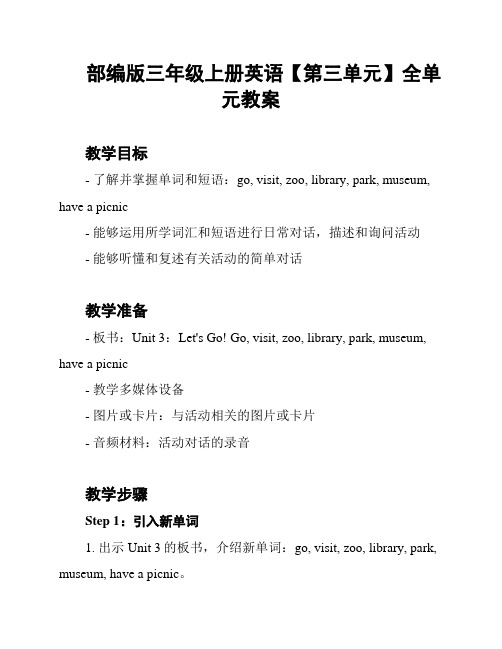
部编版三年级上册英语【第三单元】全单
元教案
教学目标
- 了解并掌握单词和短语:go, visit, zoo, library, park, museum, have a picnic
- 能够运用所学词汇和短语进行日常对话,描述和询问活动
- 能够听懂和复述有关活动的简单对话
教学准备
- 板书:Unit 3:Let's Go! Go, visit, zoo, library, park, museum, have a picnic
- 教学多媒体设备
- 图片或卡片:与活动相关的图片或卡片
- 音频材料:活动对话的录音
教学步骤
Step 1:引入新单词
1. 出示Unit 3的板书,介绍新单词:go, visit, zoo, library, park, museum, have a picnic。
2. 跟随板书,教导学生正确发音和记忆新单词。
Step 2:听力训练
1. 播放音频材料,让学生听懂并模仿日常对话中的活动内容。
2. 引导学生观察图片或卡片,听音频并回答对话中的相关问题。
Step 3:情景对话
1. 分组进行情景表演,让学生根据所学单词和短语组织对话。
2. 鼓励学生用英语描述和询问不同的活动。
Step 4:扩展活动
1. 学生自由发挥,以小组为单位设计一个周末活动计划,并用
英语展示给全班。
2. 学生评价彼此的计划,提供改进意见。
总结
通过本节课的学习,我们掌握了一些日常活动的单词和短语,
并能够用英语进行简单的描述和询问。
在以后的学习和生活中,希
望大家能够运用所学知识,与他人进行交流和分享。
六年级英语上册 Lesson3 Can I try this shirt on教案(1)
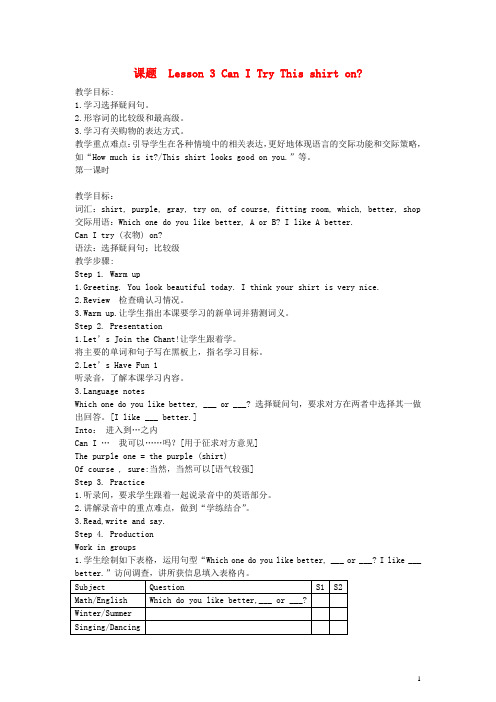
课题Lesson 3 Can I Try This shirt on?教学目标:1.学习选择疑问句。
2.形容词的比较级和最高级。
3.学习有关购物的表达方式。
教学重点难点:引导学生在各种情境中的相关表达,更好地体现语言的交际功能和交际策略,如“How much is it?/This shirt looks good on you.”等。
第一课时教学目标:词汇:shirt, purple, gray, try on, of course, fitting room, which, better, shop 交际用语:Which one do you like better, A or B? I like A better.Can I try (衣物) on?语法:选择疑问句;比较级教学步骤:Step 1. Warm up1.Greeting. You look beautiful today. I think your shirt is very nice.2.Review 检查确认习情况。
3.Warm up.让学生指出本课要学习的新单词并猜测词义。
Step 2. Presentation1.Let’s Join the Chant!让学生跟着学。
将主要的单词和句子写在黑板上,指名学习目标。
2.Let’s Have Fun 1听录音,了解本课学习内容。
nguage notesWhich one do you like better, ___ or ___? 选择疑问句,要求对方在两者中选择其一做出回答。
[I like ___ better.]Into:进入到…之内Can I …我可以……吗?[用于征求对方意见]The purple one = the purple (shirt)Of course , sure:当然,当然可以[语气较强]Step 3. Practice1.听录间,要求学生跟着一起说录音中的英语部分。
unit 3 教案新部编本2
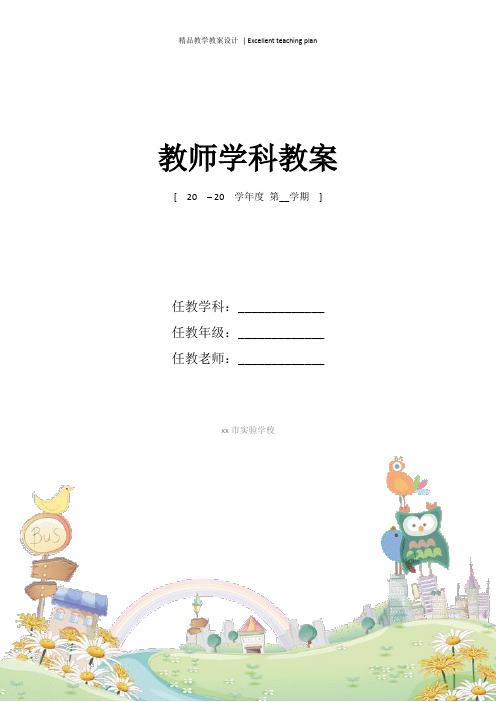
教师学科教案[ 20 – 20 学年度第__学期]任教学科:_____________任教年级:_____________任教老师:_____________xx市实验学校Unit 3 Is this your pencil?单元整体说明单元教材分析本单元围绕“识别物品的所属”,使学生学会询问物品的主人的基本句型“Is this/that your/her/his pencil? Yes, it is. No, it isn’t.”,体会一般疑问句的用法;学习如何写“失物招领、寻物启事”,巩固所学单词的拼写“How do you spell pen? P-E-N.”。
通过以上几个方面的学习,既能提高学生解决问题的能力,又能巩固所学知识。
本单元与第三单元衔接紧密:由this,that的学习过渡到these, those的学习,由指示一个人、物过渡到指示多个人、物,使学生学会区分远近单复数。
单元知识系统(树)Is this/that your/her/his pencil? Yes, it is. No, it isn’t.How do you spell pen? P-E-N. What’s this in English? It’s a pen.Lost and Found单元总体目标运用Using contest guessing的学习策略,引导学生学会询问物品的主人的基本句型;体会一般疑问句的用法;学习如何写“失物招领”,“寻物启事”。
单元教学、难点一览单元学情分析本单元的主题是识别物品的所属,同时引导学生采用Using contest guessing和Role playing 的学习策略,学习新词汇,掌握重点句型,使学生能比较好地解决类似问题(失物招领、寻物启事),既能提高学生解决问题的能力,又能巩固所学知识。
单元教学建议采用Using contest guessing和Role playing的学习策略,利用教学图片或制作多媒体课件来展开课堂Pair work, Group work的口语交际活动,识别物品的所属,体会指示代词、一般疑问句的用法。
四年级英语上册Unit3教案新部编本人教PEP(标准版)
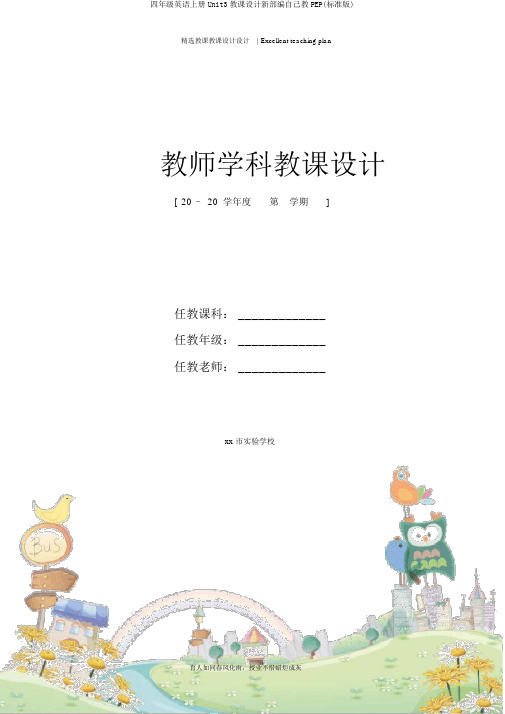
精选教课教课设计设计| Excellent teaching plan教师学科教课设计[ 20–20学年度第__学期]任教课科: _____________任教年级: _____________任教老师: _____________xx市实验学校UNIT 3 My friends单元内容剖析:本单元学习的主题是向别人介绍自己的好朋友,对挚友的性格和相貌特点进行描绘,情形图经过展现学生们介绍挚友的情形体现本单元要学习的中心词汇和句型。
单元教课建议:1、利用主情形图导入话题,帮助认识主要内容。
2、学习中心句型:What’ s his name ? His name is Zhang peng.He’s tall and strong 。
3、理解 glasses和shoes的末端es和s的发音。
4、仔细察看图片,听录音,学习Let ’ s sing。
单元教课目的:1、能够听、说、读、写单词:strong 、 friendly、quiet、hair、shoe、glasses。
2、能够听、说、认读句型:What’ s his name? His name is..,who is he?3、能够在情形中运用句型:What’ s his/her name? Who is he/she?并能够回答。
4、能够在存心义的语境中描绘话题辞汇。
5、能够掌握o— e 的发音规则,能够读出切合o— e 的发音规则的单词。
单元课时安排:共6课时。
第一课时Main scene——A Let’ s play第二课时A Let ’ s learn——A Let’ s spell第三课时B Let ’ s talk——B Let’ s play第四课时B Let ’ s learn——B Say and draw第五课时B Read and write——B Let’ s sing第六课时C Story time第一课时教课目的:1、能听懂、会说What's his name? His name is... He’s...2、能听、说、认读I have a new friend. A Chinese friend? What's his name?His name is....教课重难点:1、词汇: Chinese, friendly2、 Chinese, his的尾音教课准备:1、几张班里同学的照片。
【教学设计新部编版】Unit 3Lesson 1(人教新起点)docx.
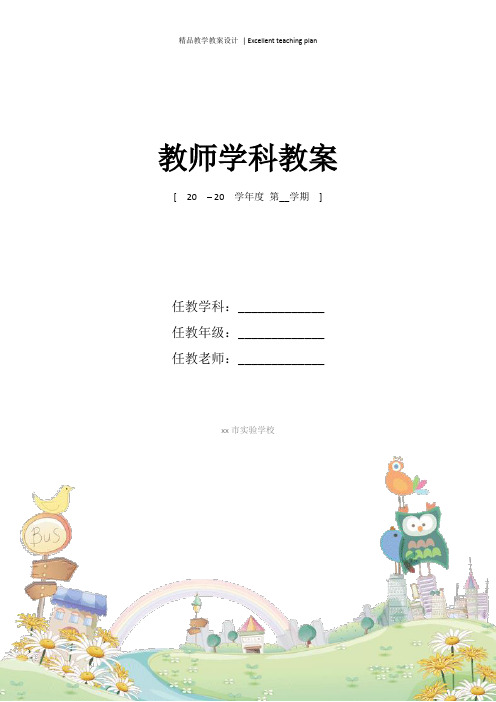
教师学科教案[ 20 – 20 学年度第__学期]任教学科:_____________任教年级:_____________任教老师:_____________xx市实验学校Unit 3 Daily LifeLesson1This is the first lesson in this Unit.【【【【【【1. Be able to listen and read the words and dialogues: What do you do on weekends?2. Be able to ask and answer questions.【【【【【【1. Be able to talk.2. Enhance students’ ability of practical applications.【【【【【【Learn to respect others when we talk with others.Learn to introduce your every day to your friends in the right way.【【【【【【◆教学目标◆教学重难点 ◆ ◆教材分析1.The relevant words and dialogues:What do you do on weekends?2.Be able to talk.【【【【【【The relevant words 【the simple past tense and dialogues.◆课前准备◆Tape recorder, Multimedia. PPT◆教学过程Step 1. Wram-upBegin by greeting the class with a smile and good morning!T: Good afternoon, students.S: Good afternoon, teacher.Step 2. Listening text and answer questionT: Let’s act.A组组7:30B组组9:00C组组5:00D组组6:30T: Let’s listen and repeat.Step 3.Read text and tell the main idea of the text in the students’ own words.Let the students speak in front of the class. Encourage them not to be shy when they stand there. Give the students chances to speak loudly in front of the class.Step 4. ReadingStep 5. Encourage the students to ask more questions about this part.Ask all of the students to take part in the discussion.Step 6. Summary1.Let the students close their books. Ask the to say what they learned in this lesson.Ask some volunteers to write on the blackboard.2.Do some exercises.Step 7. Homework1.Finish off the exercises in the textbook.2.Go on the next reading in the student book.◆教学反思【【。
四下unit3教案新部编本
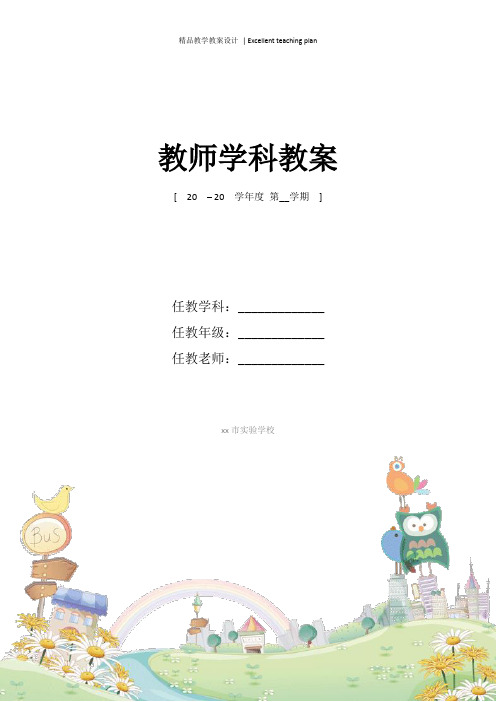
教学过程
个性修订
一、认
1、教师播放图像资料,引导学生根据人物服装来猜一猜天气情况,复习单词。
二、学
1、教师根据当时情况说:It’s hot/warm. Can I wear myshirt(sweater, skirt, dress…)?并引导学生回答:Yes,you can.或No, you can’t.并进行板书。
2、学生分小组练习:A:Can I wear my…?
B:Yes,you can./No, you can’t.
3、播放Let’s talk部分教学录像,学生观看。
4、学生看配套动画,模仿跟读。教师对学生的语音、语调进行必要的指导。
三、议
学生分角色朗读,表演对话。教师可以先与一个学生进行示范性表演,以降低本项活动的难度。
4、听音后反复读五个单词,在此基础上进行描红,达到书写格式正确的目
三、议
学生看图讨论:What can you see?
四、练
完成Look, listen and write部分的练习。
布置作业:抄本课单词4+1模式。
板书设计
教学反思
课题Weather课型新授 第四课时
教学内容:句型 :What's the weather like in New York?How about Beijing?
三、议
1、学生跟录音读对话,注意课文中首次出现语言的语音语调,注意准确模仿。
2、学生两人一组分角色读对话,教师及时进行评价。
四、练
完成Let's play部分。操练句型: A:What’s the weather like in …?
B:It’s … How about…?
三上U3第三课时教案新部编本
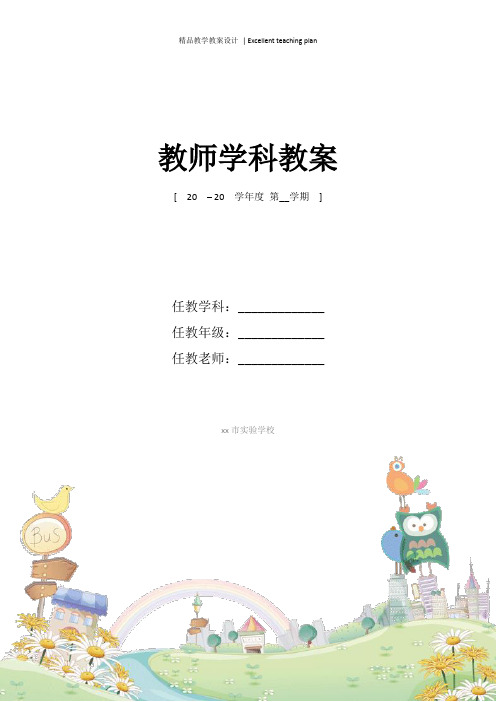
[20 – 20学年度第__学期]
任教学科:_____________
任教年级:_____________
任教老师:_____________
xx市实验学校
英语三年级上册Unit 3 My friends教学设计
主备人
朱莉
主备时间
2013.9
修改栏
Teaching content:
英语三上Unit3 My friends
(4) Let’s chant.
(5) Play a game: Quickly respond.
(6)Learn how to write the new letters.
(7) Let Ss read and write the new letters.
Step 3 Consolidation
Ticking time
1. Let’s summary.
2.Work in pairs and finish the ticking form in the book.
Step 4 Homework
1、抄写字母Hh, Ii, Jj, Kk四遍。
2、制作字母卡片Hh, Ii, Jj, Kk。
3、会唱歌曲Goodbye。
1.Checkout time.
Let’s guess: I have many friends.
Can you guess: Who are they?
(1)Show the pictures, let Ss use the sentences:
“He’s/She’s…He’s/She’s my friend.”to say.
3、能初步会唱歌曲Goodbye。
教学设计新部编版课题 Unit 3
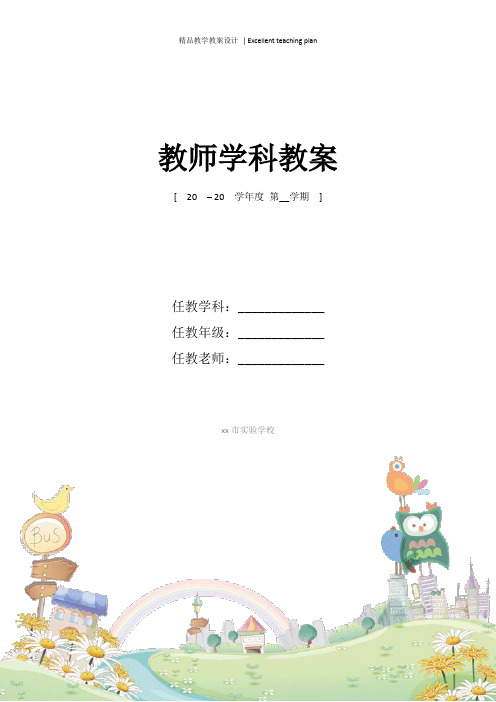
教师学科教案[ 20 – 20 学年度第__学期]任教学科:_____________任教年级:_____________任教老师:_____________xx市实验学校教学设计课题 Unit 3 Could you please clean your room?教学目标 1. 生词和短语chore, partner, dish, do the dishes, sweep, trash, take out, make one’s bed, fold, living room, meet, work on2.重点句子Could you please take out the trash?Could you please make your bed and fold your clothes?3.能力目标Enable students to make polite requests.4.学能目标Help students learn how to make polite requests with the target language.教学重点 Could for polite requests.教学难点 Could for polite requests.教具教法 Pictures, tape recording.教学过程教学活动个人复备Step 1 Warming-upSing the song and dance to the musicStep 2 Presentation1. Watch the photos and talk about them “What does he do every day?’ and learn these phrases: do chores, do the dishes, make the bed, take out the rubbish, fold the clothes, do the laundry, clean the living room.2. Look these phrases and practice the conversation: Could you please take out the rubbish? Sure. / Sorry, I can’t. I have to finish homework first.3. 1a Do you do these chores at home? Discuss them with your partner.Step 3 Listening1b Listen. Who will do these chores? Check (√) Peter’s mother or Peter.Chores Peter’s mother Peterdo the dishessweep the floortake out the rubbishmake the bedfold the clothesclean the living roomStep 4 Practice1c Make conversations about the chores in 1a.Make conversations.ExamplesA: Could you please...?B: Yes, sure. /All right. /No problem./Certainly.Sorry, I can't. I have to do...Sorry, I can't. I am doing...Step 5 Listening 2a&2bPeter asks his father if he can do four things. What does his father say? Check (√) “yes” or “no”. Listen again. Draw lines to the reasons.Peter wants to…Peter’s father says…His father’s reasonsgo out for dinner. Yes No I have to do some work.go to the movies. Yes No You have to clean your roomstay out late. Yes No I need to eat breakfast.get a ride. Yes No You have a basketball game.Step 6 Practice2c Make conversations using the information in 2a and 2bA: Could I use your computer?B: Sorry. I’m going to work on it now.A: Well, could I watch TV?B: Yes, you can. But first you have to clean your room?2d Role –play the conversation Step 7 Language points and summary1. help out 动词短语,表示在某人繁忙或遇到困难时“给予帮助”。
Unit3教案新部编本第一课时
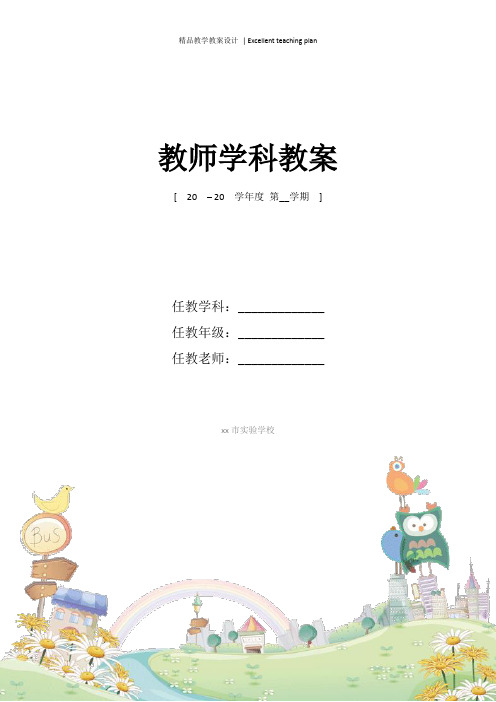
教师学科教案[ 20 – 20 学年度第__学期]任教学科:_____________任教年级:_____________任教老师:_____________xx市实验学校Unit 3教案第一课时一、教学目标1.能够听、说、认读句型:“What are you going to do this evening? Im going to the cinema.”并能对其中的动词和时间短语进行替换操练。
2.能够听、说、认读动词短语:take a trip,go to the cinema,read a magazine.3.能够听、说、读、写时间短语:next week,this morning/afternoon/evening;并能够听、说、认读时间短语:tomorrow,tonight.4.能够在Pair work中合理安排自己的活动时间并与他人进行交流。
二、教学重、难点1.本课时的教学重点是能够听、说、读、写Lets learn部分的四会短语;并能替换going to do句型中的动词和时间短语对将来的活动进行表述。
2.本课时的教学难点也是四会词汇的听、说、读、写以及对be going to do句型了解和替换操练。
三、课前准备1.教师准备动词短语卡片,如:take a trip,go to the cinema等。
2.教师准备Lets start部分的教学挂图。
3.教师准备录音机和本课时的录音带。
四、教学步骤和建议1.热身(Warm-up)(1)教师课前放本单元歌曲“What Are You Going to Do?”学生初步感知be to do句型。
(2)师生进行日常会话,可将重点放在动词短语的问答上,如:2.预习(Preview)(1)教师出示课前准备好的课程表,说“Look!We have so many classes in a指着Monday说:“What classes do we have on Mondays?’帮助学生一起说“On Mondays,we have English,Chinese,math.…”再请学生回答其他几个的课安排。
Unit3教案新部编本
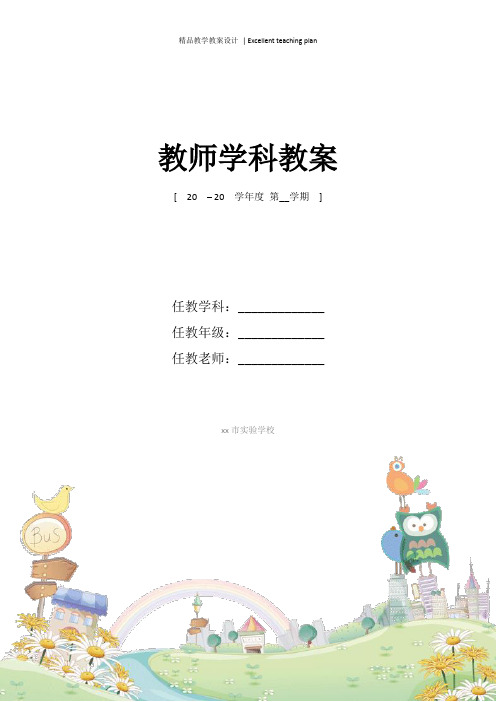
教师学科教案[ 20 – 20 学年度第__学期]任教学科:_____________任教年级:_____________任教老师:_____________xx市实验学校Unit3 This is my sister. 教学设计Section A初一年级组郭爱华2011--10Unit3 This is my sister. 教学设计刁山坡中学郭爱华教学目标:1.知识目标:(1).单词:mother, father, sister, brother, grandmother, grandfather, friend, grandparent,uncle, aunt, cousin, parent, daughter, son, these, those, they, he, she(2).句子:This is my brother. These are my parents.Is she your sister? Yes, she is . / No, she isn't.Is this/ that your/ his / her friend? Yes, it is./ No, it isn't.(3). 语法:让学生正确使用"be"动词"is"," are",以及指示代词"this", "that", "these", "those"的用法。
语言设计情景:让学生出示照片或图片来介绍家人或朋友。
2.技能目标:(1).确认家庭成员,能用英语表达家庭成员:妈妈、爸爸、兄弟、姐妹、祖父、祖母、父母、朋友、这个、那个、这些、那些(2).运用句型This/That is…,These/ Those are…介绍家人及朋友。
3.情感目标:让学生在具体的语言情境的交际中,感受英语所带来的实用性及成功的喜悦,增强学生学习英语的兴趣和信心;通过对家庭成员之间关系的描述,增进学生热爱家人的情感,以及增进同学之间对彼此家庭的了解;鼓励学生之间地积极的良性的交往及合作,培养友好互助的精神。
四年级上册 unit3 教案新部编本
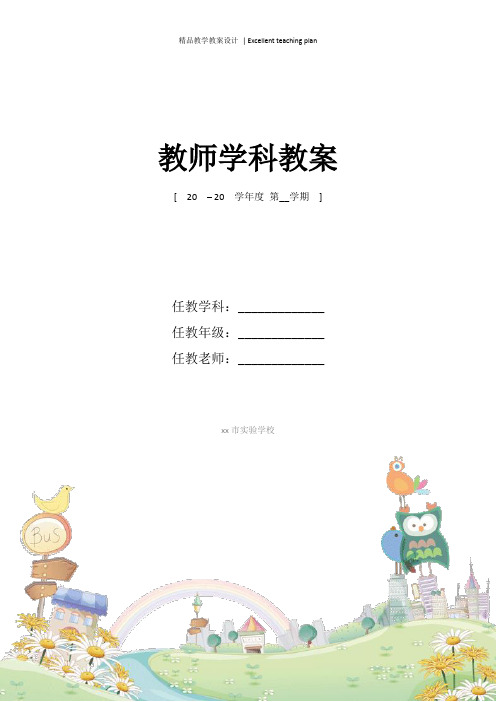
教师学科教案[ 20 – 20 学年度第__学期]任教学科:_____________任教年级:_____________任教老师:_____________xx市实验学校四年级上册Unit3 My friends Part B教案一、教学目标:知识目标:(1)能听、说、认读本课时的主要的单词:glasses 和shoes。
(2)能听懂、会说“He’s....He has...and his shoes are...”并能在实际情景中运用。
能力目标:能综合运用所学语言进行交流,向别人介绍自己的朋友及其特征。
情感目标:通过本课的学习使学生乐于听、说英语,乐于模仿,积极参与,培养学生的合作精神,学会珍惜朋友之间的友情。
二、教学重难点(1)重点:能够在实际生活中,结合一定的语言情景描述朋友的特征能够在情景中恰当运用句型He has…and his…描述外貌特征;能够在语境中理解新词or,right,glasses,shoe的意思,并能正确发音。
(2)难点:glasses和shoes的末尾-es和-s的发音需要重点关注。
三、教学过程:Step1.Warm-up(热身复习)(1)Greeting with Ss.为学生创造听说英语的氛围。
(2)Let’s chant(听听唱唱):Tim is my friend.He’s a good good boy...【设计意图】通过听听、做做、说说,为学生营造了良好的英语学习氛围,激发学生英语学习的兴趣。
同时,不仅复习已学过的知识,而且为新知识的学习作了铺垫。
)Step2.Presentation(新知呈现)(1)A guessing game:boy or girl...让学生在复习旧知的同时,理解新词or,体会Yes,you are right.句子的含义。
寓教于乐。
(2)Game2:“说名字”通过PPT上出现的一系列图片询问他人姓名并回答,最后引出新知:He has glasses.【设计意图】选取贴近学生生活的图片,新颖,学生感兴趣。
Unit 2 Clothes Lesson 3 Whose coat is this 教案新部编本
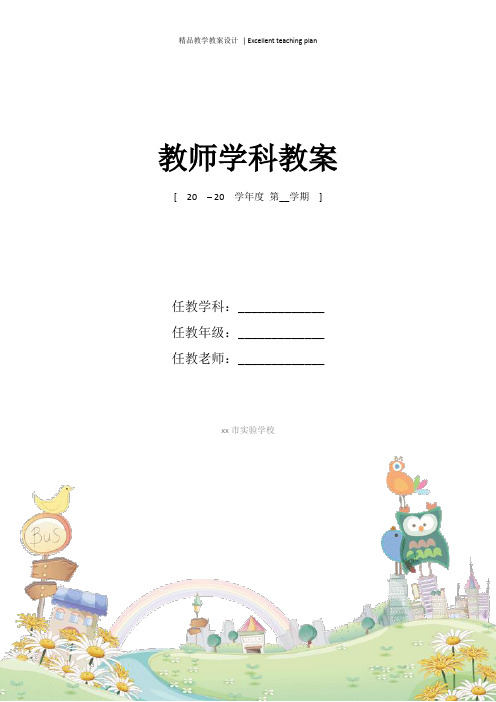
教师学科教案[ 20 – 20 学年度第__学期]任教学科:_____________任教年级:_____________任教老师:_____________xx市实验学校Unit 2 ClothesLesson 3 Whose coat is this?教案教学目标(Objectives):1.确保学生认识和理解一些基本单词的意义和简单口头运用(To learn the meaning and simple usages of some words and phrases)。
需要掌握的词组:coatwhoseshirt2.学习使用本单元重点句型及表达(To use the typical sentences to express)。
需要掌握的句型:Whose coat is this?It’s Jane’s.…3.鼓励学生大胆发言及表达(To encourage the students to express bravely)。
4.培养学生对英语学科的兴趣(To make the students interest in English learning)。
5.增强学生听说读写译的能力(To strengthen the ability of listening, speaking, reading, writing and translating)。
教学重点(Key Points):在学习了单词的基础上,以单词为载体,进行主要句型的学习,并了解其中的语法现象,根据具体情境,学会交流对话,侧重句型语法学习,交际意向和课外拓展为重点。
教学方法:游戏,音频,情景教学法,Pair-work两人小组活动,Group-work小组活动,多媒体辅助教学。
教学难点:学生处于小学阶段,对英语有了初步了解,词汇储备较少,对于三年级下学期学生的要求重点是在会读会说的基础上,能掌握一些基本单词的拼写和造句,了解一定的语法内涵,与人进行简单沟通交流。
- 1、下载文档前请自行甄别文档内容的完整性,平台不提供额外的编辑、内容补充、找答案等附加服务。
- 2、"仅部分预览"的文档,不可在线预览部分如存在完整性等问题,可反馈申请退款(可完整预览的文档不适用该条件!)。
- 3、如文档侵犯您的权益,请联系客服反馈,我们会尽快为您处理(人工客服工作时间:9:00-18:30)。
教师学科教案[ 20 – 20 学年度第__学期]
任教学科:_____________
任教年级:_____________
任教老师:_____________
xx市实验学校
Lesson3 Can I try this shirt on ?(4)
EEC六年级上册教案刘春梅
知识目标:1.学习形容词的比较级和最高级
big --- bigger ---- biggest ; small ---smaller ---- smallest
2.巩固交际用语
...... is too( big/ small ) for someone .
Do you have a(smaller/ bigger) one ?
This is the( smallest /biggest) one .
过程方法:会话表演法、合作交流法、唱歌谣
情感态度:引导学生通过购物情境表达体验生活,提高学生语言交际能力,增强学生学习英语的兴趣与自信心,体验学习成就感,形成积极的学习态度。
教学重点:1.词汇: big --- bigger ---- biggest
small ---smaller ---- smallest
2.句子: ...... is too( big/ small ) for someone .
Do you have a(smaller/ bigger) one ?
This is the( smallest /biggest) one .
教学难点:对形容词及它的比较级和最高级的正确运用; 就购物情境设想编写对话并表演。
教具:课件、图片、衣物、录音机、彩粉笔
教学过程:
Step1.Free talk
T: Hello,everyone .
Ss: Hello,teacher .
T:How are you ?
Ss: I’m fine . And you ?
T: I’m fine ,too. Thanks . Can you say the opposite adjective ?
Ss: Yes.
T: Stand up ! I say big .( 手势表示出来)
Ss: I say small.
T: I say tall.
Ss: I say short.
T: I say thin.
Ss: I say fat.
T: I say short.
Ss: I say long.
T: Good boys and girls.
Step2.Lead-in.
1.T: Do you have brothers or sisters ?
Ss: Yes.
T: Our adjective friends also have brothers and sisters ,too. Let’s know it .
( 看课件,我们的形容词兄弟姐妹来了可。
)
Learn: big --- bigger ---- biggest
small ---smaller --smallest
long—longer—longest
short---shoter---shotest
2.Exercise
T: How can we make friends with them? Let’s see together.
1. ShirtM is big.
2.Shirt L is bigger.
3.Shirt XL is the biggest .
4.Green pants are short .
5.Black pants are shoter .
6.Pink pants are the shotest .
Step3. Presentation.
1.T: You are excerllent. Today ,we go on lesson 3Can I try this shirt on ?
( 板书:Lesson3 Can I try this shirt on ?(4),then turn to page 38.) T: Let’s learn together .Look at picture1, Who are they ?What does Xiao xiao want to buy ? What about the shirt ? What does Xiao xiao ask ?
板书:Lesson3 Can I try this shirt on ?(4)
This shirt is too( big/ small ) for someone .
Do you have a(smaller/ bigger) one ?
This is the( smallest /biggest) one .
T: Look at the blackboard ,Who can read ?
Call two students to read the sentences ,and others follow him /her .
2.Listen to the chant.
( First ,chant together; Second, chant by boys and girls .)
3.Practise the sentences
T: Today ,our friends comes here to see us . They are very happy ,but today they need our help .They can’t choose what to wear . Can you help them ?
Ss: Let’s have a try .
Step 5. Listen and choose the thing for the kid.
Step6. Read and choose the sentence for the empty bubble.
Step7. Extra exercise.
T: Boys and girls , if you are shopping What do you want to buy ?
S1: a shirt . S2: Sweater . S3: Some food . S4: Book.
T: Ok. I give you a chance to come true it . First, you take out exercise book,make dialogue and write down what you want to buy . Then , let’s act it out .
Step8. Act dialogue.
Step9. Sum up .
Step10. Sing a song《If you are happy.》
Home work : Make sentences with the words : big 、small 、long and short .
板书:Lesson3 Can I try this shirt on ?(4)
This shirt is too( big/ small ) for someone .
Do you have a(smaller/ bigger) one ?
This is the( smallest /biggest) one .
课后反思:
1. TPR 活动以旧引新,注重相关知识的衔接
TPR 活动能调动学生的学习积极性,并且使学生的注意力快速集中,进入本节课的学习,营造了良好的英语学习氛围。
学生通过TPR 活动复习了本节课要用的已学知识:big 、small 、long and short ,为学习新语言知识做好了铺垫。
2.利用现代教育技术
本课灵活、恰当地运用了多媒体技术辅助教学。
多媒体课件色彩鲜艳,图象逼真,将抽象的形容词的比较级、最高级变化过程化为简单易懂的实物演示,帮助学生理解了形容词的比较级、最高级词汇概念。
从而激发了学生的学习兴趣,使学生多角度轻松地吸收学习内容,并使其记忆长久。
3.任务联系了学生生活
本节课设计的任务紧密联系了学生的生活。
比如,在巩固交际用语......
is too( big/ small ) for someone .Do you have a(smaller/ bigger) one? This is the( smallest /biggest) one . 让学生实现心中的购物梦想,开展购物表演。
在表演的过程中,学生可以利用黑板上的重点句型,也可以对所学的对话加以适当改编,创编新的对话。
这样的任务型活动不仅将新旧知识有机结合起来了起来,同时还训练了学生联系生活实际运用所学语言的能力。
本节课也存在着不足之处:
1.在句型练习环节上,学生虽理解句型,但有时表达不清楚,教师应给学生做出示范,帮助学生正确运用句型。
2.学生在回答和朗读中出现的错误,教师应及时纠正过来。
3.教师教学用语要简单些,便于学生理解,提高课堂效率。
对学生的语言训练还有待于提高,把握语言使用的准确性。
